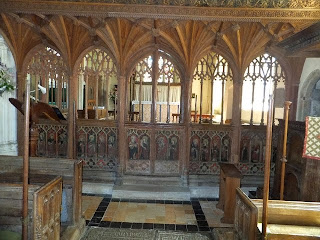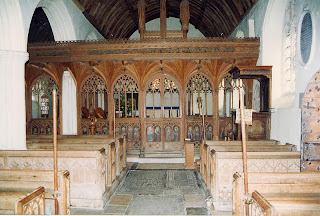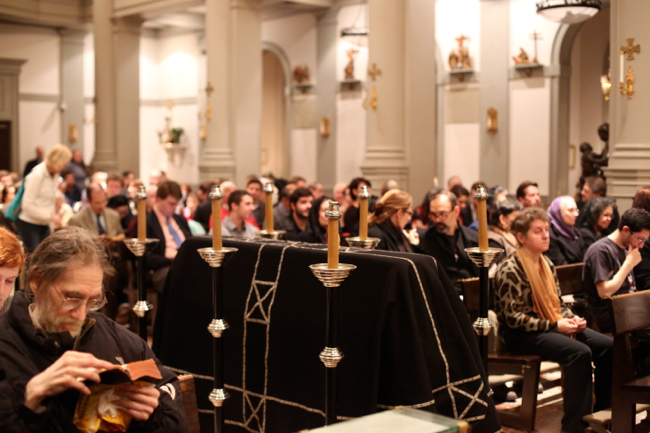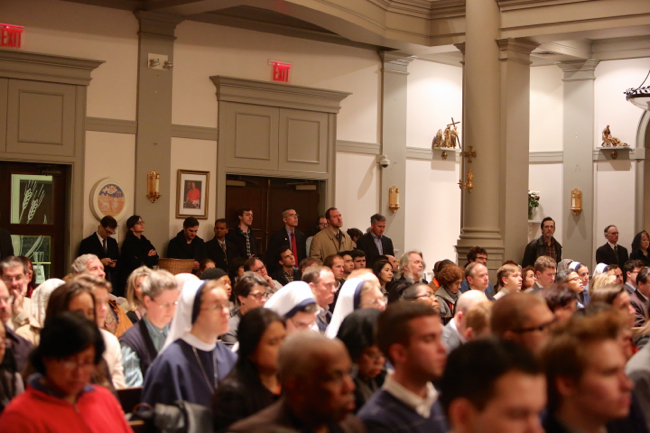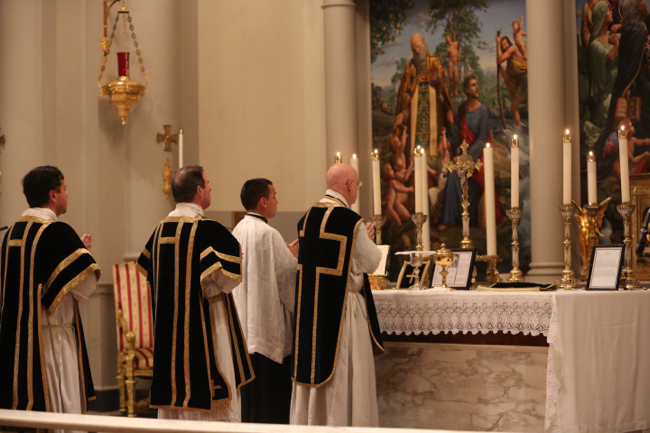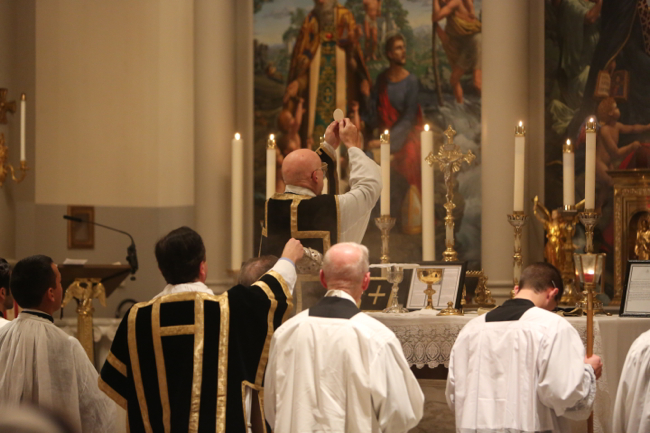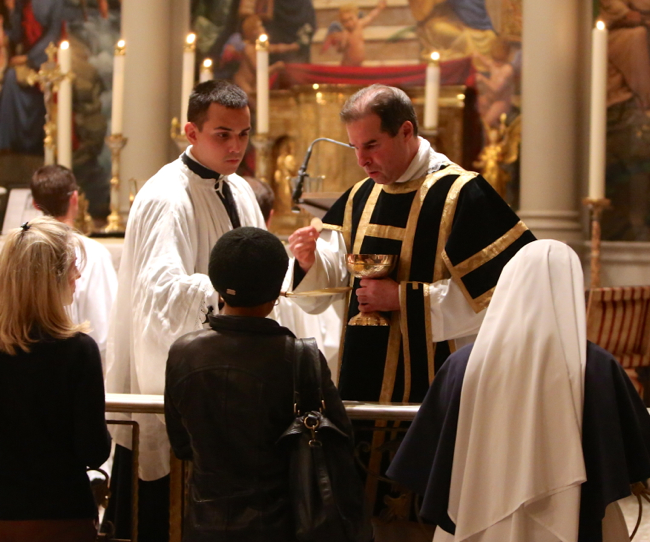Sociological Effects of Liturgy," an address by the Reverend Peter M. J. Stravinskas, Ph.D., S.T.D., at the “Faith of Our Fathers” conference in Kilkenny (Ireland), 13-15 September 2013.
We hear a great deal today about “culture”: the youth culture, the culture of life, the culture of death, the anti-culture. And so, I would like to begin my reflections by demonstrating the connection between culture and worship. As a die-hard Latin teacher, I want to establish the etymological linkage. The word
cultura (culture) comes from the word
cultus (cult, as in “worship”). To enter into a language is to enter into the mindset of a people. Thus, one can say that for the ancient Romans, “culture” was rooted in “cult” or worship. We can smirk at the Greeks and Romans of old with their thousand little gods and goddesses inhabiting the Pantheon but, for all that, they still lived with a transcendental horizon. In other words, the individual human being was answerable to a higher and ultimate authority. And within that horizon, those peoples forged impressive cultures. Similarly, within the Christian scheme of things, we find that what many historians have dubbed “The Age of Faith”– the high middle ages – produced a nearly unimaginable outpouring of literature, art, music and architecture – unrivaled to this very moment.
On the other hand, we look at the century to which we have only recently bade adieu and what do we encounter? What many commentators have labeled “the century of blood.” Indeed, more people died in the wars and under the repressive, godless regimes of the twentieth century than in all previous eras combined. The Fathers of the Second Vatican Council got it right in asserting that “without the Creator, the creature vanishes” (
Gaudium et Spes, n. 36). That should be the object lesson we carry with us through this century and which we imprint on the consciousness of our people, especially the young.
Sociologists of religion remind us that worship always occurs within a context: cultural, political, sociological, religious. Worship forms for the Catholic community underwent a tremendous change in the aftermath of the Second Vatican Council. The Council itself was a great blessing to the Church, but it took place in a time of unparalleled social upheaval. Not to have lived then is to be almost incapable of appreciating the degree of confusion and uprootedness which characterized the years of Vatican II and, most especially, its immediate aftermath. To many, it appeared that the train of the Church had been derailed, and one of the first victims of that crash was the Sacred Liturgy. If the plan of the Council Fathers had been followed; if unlawful experimentation had not been tolerated; if unwarranted and unwise changes had not been introduced; things would have been different. Cardinal Malcolm Ranjith, Archbishop of Colombo in Sri Lanka and former Secretary of the Congregation for Divine Worship in Rome, elucidates this: “The careful reading of the conciliar Constitution on the Sacred Liturgy,
Sacrosanctum Concilium, shows that the rash changes introduced to the liturgy later on were never in the minds of the Fathers of the Council.” (1)
Indeed, the life of the Church would not have been so massively disrupted, as so sadly reflected in: the 75% decline in Sunday Mass attendance; the 65% decline among women religious; the loss of approximately 100,000 priests worldwide during the last decade of Pope Paul VI's pontificate; the halving of our Catholic school system in the United States. Social theorists would warn that one cannot tinker with the signs and symbols of the liturgy without affecting the very existence of the Church. Why? Because the Church takes her life from the liturgy; hence, the very title of Pope John Paul II’s final encyclical,
Ecclesia de Eucharistia (the Church comes from the Eucharist). It is for this very reason that every pope of the post-conciliar period has endeavored, step by step and brick by brick, to recapture what was imprudently discarded and to discard what was thoughtlessly introduced – but now in a somewhat calmer historical setting, albeit with problems of its own.
The question then surfaces: Whom are we seeking to introduce to a life of worship? I would recommend focusing on the young, if for no other reason than the fact that the elder generation is rather solidly formed (or deformed) and unlikely to change. Saint Paul showed himself to be an exemplary teacher when, before preaching to the population of Athens, he toured their city, endeavoring to learn about their culture. Although he was not totally successful in linking up the Gospel message with the cultural reality he found in Athens, he did zero in on a crucial point of reference in his discussion of the “unknown god” whom they worshiped (cf. Acts 17:23). Cult and culture merged. Following his example, many of us in Catholic education have sought to engage the culture of our students by listening to their music, watching their films, and learning their lingo. Those who have been in the business for thirty or more years will remark that today's youth are quite different from those we met as we embarked on our teaching careers.
I would summarize the picture in these terms: They are, in effect, a
tabula rasa– a blank slate, especially from a religious standpoint. Talking to them about Vatican II as though it had happened yesterday (which is often the impression some folks of my generation give) has the same effect as talking to them about Nicea II. The theological battles and liturgical wars of the sixties and seventies are not on their radar screen; which is to say that they don't have the baggage of the “boomers.” They tend to be rather open to traditional approaches to Catholic life and worship, perhaps as a kind of “reaction formation” to what they have experienced of instability in the Church, society-at-large, and their own families.
My anecdotal data is actually carefully detailed in Colleen Carroll's book,
The New Faithful: Why Young Adults Are Embracing Christian Orthodoxy. (2) If you have not read this work, you must do so, as it provides invaluable information on who these young people are, how they think and, yes, how they feel.
Permit me to quote extensively from Miss Carroll's findings. She asks:
Why are young adults who have grown up in a society saturated with relativism – which declares that ethical and religious truths vary according to the people who hold them – touting the truth claims of Christianity with such confidence? Why, in a society brimming with competing belief systems and novel spiritual trends, are young adults attracted to the trappings of tradition that so many of their parents and professors have rejected? Is this simply the reaction of a few throwbacks to a bygone era, a few scattered inheritors of a faith they never critically examined? Is it the erratic behavior of young idealists moving through an inevitably finite religious phase? Or are they the heralds of something new? Could these young adults be proof that the demise of America's Judeo-Christian tradition has been greatly exaggerated? (3)
Boston College philosopher Peter Kreeft answers thus: “It's a massive turning of the tide.” He goes on: “Even though they know less history or literature or logic” than students ten or twenty years ago, “they're more aware that they've been cheated and they need more. They don't know that what they're craving is the Holy Spirit.” (4)
Miss Carroll explains:
The young adults profiled in this book also differ substantially from their grandparents, though their moral attitude and devotional practices often look surprisingly similar. Most of their grandparents inherited a religious tradition that either insulated them from a culture hostile to their beliefs or ushered them into a society that endorsed their Christian worldview. Today’s young Americans, regardless of their religious formation, have never had the luxury of accepting orthodoxy without critical reflection. The pluralistic culture they live in will not permit it. Nor do most of them want to be religious isolationists confined to spiritual, religious, and cultural ghettos of their own construction. They intuitively accept the religious tolerance that marks a postmodern culture, yet they refuse to compartmentalize their faith or keep their views to themselves. Though they express their values in different ways, most of these young adults are intent on bringing them to bear on the culture they live in and on using their talents and considerable influence to transform that culture. (5)
She then spells out the salient characteristics of this generation over a two-page spread. Again, I would urge you to read her material carefully and even prayerfully. (6)
As I was reading her list, I could you hear echoes of the young I have known and taught, and the descriptor that came to mind was “dynamic orthodoxy.” If even half of her characterizations are accurate, we have great, good reason for hope. It should be mentioned that Carroll’s findings are not limited to Catholicism; in reality, they cross denominational lines. Interestingly, much contemporary research shows that the most striking turns toward tradition can be found within Judaism, where Reform Judaism has lost considerable ground, while Orthodoxy has grown by leaps and bounds, to the amazement of most observers. In this regard, it is worth consulting works like those of D. Michael Lindsay and George Gallup, Jr., with their intriguing titles:
Surveying the Religious Landscape and
The Gallup Guide: Reality Check for 21st-Century Churches.
Well, if young Catholics are our target audience, what should we be doing with them in terms of worship? I began by saying that I believed this generation was a tabula rasa, for better and for worse. On the positive side of the ledger, the tired ideological battles of the sixties and seventies, as well as the liturgical wars of the eighties and nineties, are not theirs; they have a profound desire to encounter God; the Church herself is in the process of reassessment and re-grouping, liturgically speaking. On the negative side of the ledger, they have little understanding of Church history and theology and, all too often, very little experience of liturgy which is uplifting, letting them obtain even a fleeting glimpse of the eternal, which is to say that the element of mystery is generally lacking. The “negatives” stack up to form a kind of collective amnesia; actually, it’s not really amnesia for them because that refers to the state of having forgotten something, whereas this generation, for the most part, has never even heard these things at all. However, “amnesia” is a useful word nonetheless because it is the amnesia of the elders (clergy, educators, parents) that has produced this gaping hole in the religious experience of these young people. And amnesia has fatal consequences for adherents to a religion whose Lord and Founder commanded them to observe
anamnesis or sacred memory on the eve of His Passion and Death (cf. Lk 22:19).
Amnesia and
anamnesis cannot co-exist in a community or individual.
For two consecutive years, on the feast of Saint Gregory the Great, I delivered homilies at the Church of the Holy Innocents on 37thStreet in Manhattan, focused on what I thought was needed for that “reform of the reform”promoted by the then-Cardinal Ratzinger. In 1996, I highlighted several “gaps” in contemporary Catholic life which make worship “in spirit and in truth” (Jn 4:23) difficult, if not impossible: the neglect of eschatology in teaching and preaching; a misreading of
Sacrosanctum Concilium; an exaggerated emphasis on the horizontal, to the detriment of the vertical; a lost sense of sin; excessive subjectivity; the reduction of the language, art and music of worship to the least common denominator; celebration of sacraments without requisite faith or knowledge. The following year, I identified some important needs, if the Sacred Liturgy is to fulfill its purpose: reverence; beauty; appreciation for divine transcendence; learning (or re-learning) the meaning of symbol and ritual. I would be happy to share the full text of those homilies with anyone who is interested.
I would not be true to myself were I not to call to my side at least once during a lecture the great Blessed John Henry Cardinal Newman. It seems that the convert-apologist had a somewhat extended correspondence with a Protestant minister on the nature of true worship. At a certain point, the minister wrote: “Well, Dr. Newman, I suppose we shall simply have to agree to disagree. You will worship God in your way, and I in mine.” With typically British wit, the Cardinal replied: “Oh no, reverend sir. You should certainly feel free to worship God in your way, but
I shall worship Him in
His way!” You see, liturgy – like the Faith it celebrates – never admits of an “erector-set” approach; good liturgy, true liturgy is received, not fabricated, and it takes seriously the human person in all his complexity of body and soul.
One hundred and fifty years later, Cardinal Ranjith echoed Newman’s sentiments: “Liturgy. . . can never be what man creates. For if we worship the way we want and fix the rules ourselves, then we run the risk of recreating Aaron’s golden calf. We ought to constantly insist on worship as participation in what God Himself does, else we run the risk of engaging in idolatry. Liturgical symbolism helps us to rise above what is human to what is divine.”
This is precisely what St. Thomas Aquinas saw so clearly and enunciated so clearly in his Summa:
The chief purpose of the whole external worship is that man may give worship to God. Now man's tendency is to reverence less those things which are common, and indistinct from other things; whereas he admires and reveres those things which are distinct from others in some point of excellence. Hence too it is customary among men for kings and princes, who ought to be reverenced by their subjects, to be clothed in more precious garments, and to possess vaster and more beautiful abodes. And for this reason it behooved special times, a special abode, special vessels, and special ministers to be appointed for the divine worship, so that thereby the soul of man might be brought to greater reverence for God. (I-II, q. 102, a. 4)
Cardinal Newman likewise deals with this matter extensively and brilliantly in a sermon he preached fourteen years before his reception into the Catholic Church. He confronts the objections already present in his day, which sound so familiar in ours. To those who argue that liturgical “niceties” are “indifferent matters; we do not read of them in the Bible,” Newman offers an cogent reply:
The Bible then may be said to give us the spirit of religion; but the Church must provide the body in which that spirit is to be lodged. Religion must be realized in particular acts, in order to its continuing alive. . . . There is no such thing as abstract religion. When persons attempt to worship in this (what they call) more spiritual manner, they end, in fact, in not worshiping at all.
Finally, he presents a rationale for a life of worship consonant with both the doctrine of the faith and the needs of the human person: “Rites which the Church has appointed, and with reason, – for the Church's authority is from Christ, – being long used, cannot be disused without harm to our souls.” (7) Pope Francis zeroed in on this point during his now-famous airborne press conference returning from Rio de Janeiro. He offered a comparison between the Roman Rite and Eastern Christianity. “In the Orthodox Churches,” he said, they have kept the pristine liturgy, so beautiful. We have lost a bit the sense of adoration. They keep, they praise God, they adore God, they sing, time doesn’t count. God is the center, and this is a richness. . . .”
So, where do we go with all of this? If Colleen Carroll has accurately taken the pulse of today’s youth, as she asserts without fear of contradiction, that “today's postmodern young adults are not. . . concerned with having a purely rational modern faith, . . . Instead, young adults. . . are ‘rebelling’ by embracing traditional worship”; and if Cardinal Newman and the post-conciliar popes are right about the nature of Christian worship; I want to propose a two-fold program for liturgical renewal, which will aid in the overall renewal of the Church, to be pursued with much urgency. In a 2009 address to Catholic educators in Rome, Pope Benedict spoke of “a worrying educational emergency in which the task of those called to teach assumes particular importance." (8) “A worrying educational emergency.”
The first plank in the program ought to be a serious and well-organized presentation of the history and theology of Catholic worship, introducing the “greats” of the liturgical movement of the nineteenth and early twentieth centuries (e.g,, Dom Guéranger, Louis Bouyer, Joseph Jungman), to be sure, without neglecting the Fathers of the Church and the grand sweep of liturgical life spanning twenty centuries. Special attention should be given to the landmark encyclicals of Popes St. Pius X and Pius XII on the Sacred Liturgy, and, of course, to Vatican II’s Sacrosanctum Concilium. With the first plank in place, then the second should be providing the finest examples of liturgy through Masses, holy hours, Penance services, and the Liturgy of the Hours by having recourse to beautiful vestments and vessels, as well as music which reflects our noble tradition with Gregorian Chant, Renaissance polyphony, and worthy hymnody; in other words, having the sacred rites executed with dignity and solemnity, thus opening the door for participants to cross the threshold of the Liturgy of Heaven.
Speaking to American bishops in 2011, Benedict XVI made some interesting observations:
In these days, the Church in the United States is implementing the revised translation of the Roman Missal. I am grateful for your efforts to ensure that this new translation will inspire an ongoing catechesis which emphasizes the true nature of the liturgy and, above all, the unique value of Christ’s saving sacrifice for the redemption of the world. A weakened sense of the meaning and importance of Christian worship can only lead to a weakened sense of the specific and essential vocation of the laity to imbue the temporal order with the spirit of the Gospel. (9)
Shall we draw out some of the “connections” the Pope made? First, he notes the critical importance of the “new and improved” English translation of the Mass which, despite all the dire predictions of some nay-sayers, did not result in any of the faithful being hospitalized for heart palpitations or in a 90%-drop in Mass attendance! On the contrary, as Pope Benedict pointed out, the more accurate and more sacral text provides access to a richer mystagogical and liturgical experience. Secondly, because of those two results, a third should follow, namely, taking what is received in the sacred rites and bringing that to the world. Simply put, good liturgy produces vigorous evangelization.
What would I classify as “good liturgy”? Let me bring an Evangelical theologian to my side using the
via negativa:
. . . defining Christian faith as a personal choice based on well-informed convictions and inspired by emotionally engaging worship is a formula for spiritual formation that may be natural to us – but it may have elements that are foreign to the experience of other Christians in other cultures or in other centuries. I imagine that fifth-century Christians would feel utterly lost in a modern church with its worship band and theater seating where lighting, sound, refreshments, and visual media are closely monitored. They might wonder if this
modern church was chiefly indebted to entertainment, like a tamed, baptized version of Rome’s public arenas. (10)
Gary Burge, I believe, is on the Catholic liturgical trail but meanwhile offers us some fraternal, ecumenical advice on the need to avoid “liturgy as entertainment.”
Which leads to its corollary, the need to restore the lost sense of the sacred, especially as that relates to the Holy Eucharist.
Thomas Merton, in his spiritual autobiography, recalls his reception into the Catholic Church at Corpus Christi Church in New York City, especially his First Holy Communion:
I saw the raised Host – the silence and simplicity with which Christ once again triumphed, raised up, drawing all things to Himself – drawing me to Himself. . . . I was the only one at the altar rail. Heaven was entirely mine – that Heaven in which sharing makes no division or diminution. But this solitariness was a kind of reminder of the singleness with which this Christ, hidden in the small Host, was giving Himself for me, and to me, and, with Himself, the entire Godhead and Trinity – a great new increase of the power and grasp of their indwelling that had begun [in me] only a few minutes before at the [baptismal] font . . . . In the Temple of God that I had just become, the One Eternal and Pure Sacrifice was offered up to the God dwelling in me: The sacrifice of God to God, and me sacrificed together with God, incorporated in His incarnation. Christ born in me, a new Bethlehem, and sacrificed in me, His new Calvary, and risen in me: Offering me to the Father, in Himself, asking the Father, my Father and His, to receive me into His infinite and special love. . . . (11)
Now, permit to share two more recent reactions to the Blessed Sacrament.
A couple of years ago, I met a young Sister who informed me she taught second grade. I responded enthusiastically, “Ah, what a joy. You must be preparing the little ones for their First Holy Communion.” Her face fell as she said, “Yes, Father, but although I have taught them the full teaching of the Church on the Eucharist, I don’t sense the wonder and awe within them that I had at their age.” I replied that I had no doubt that she had presented a full-throated, orthodox catechesis on the Real Presence but then asked about liturgical practices in her parish: Did they employ lay ministers of Holy Communion or only the ordained? Did most people receive on the hand or on the tongue? Did most stand or kneel? In each instance, the more “progressive” mode was operational, leading to the “disconnect” between the doctrine Sister had taught and the liturgical symbol system of the parish, which suggested nothing to inspire the awe and wonder that the young nun so wanted for her children.
Not long ago, I was substituting for a priest for a week of daily Masses, with a fourth-grade boy serving the whole time. Gus was a most focused, precise and devout server. At the end of the week, I posed what we Yanks refer to as the “$64,000 question”: “Gus, you’re an excellent altar boy. Have you ever thought about the priesthood?” “Yes, Father,” came the swift response. “Well, you keep thinking and praying about it because when I was your age, I already knew that God wanted me to be a priest.” To which came the final sally: “Oh, I don’t want to be a priest anymore. I found out that you guys have to study for a long time and you don’t make that much money. And besides, my grandma already gives out Communion!” A fourth-grader’s perception? Why study for years to earn a pittance when the local hair-dresser can seemingly do what you do? Once more, the signs and symbols did not function properly.
Of course, the basic flaw in all this is that most unhealthy desire to “accommodate” the culture, rather than to transform it, which is secularization, defined by Pierre Hegy as “a process by which the overarching and transcendent religious system of old is being reduced in modern functionally differentiated society as a subsystem alongside other subsystems.” With the consequence that “the
societal significance of religion is greatly diminished.” (12) Hegy suggests a fascinating linkage between truly transcendental liturgy and adherence to traditional doctrine and morality:
The Eucharist has always been central to Catholics, with the paraliturgical devotions of the Forty Hours, nocturnal adoration, . . . Benediction of the Blessed Sacrament, and Eucharistic congresses. When personal religion was intense, as often was the case in the pre-Vatican II Church, the objective dimension emphasized by the hierarchy could easily be accepted. But once these devotions fade away, official church teaching comes to be seen as an unacceptable imposition. (13)
Antiseptic liturgy is but a by-product of that “liberalism in religion” decried by Cardinal Newman in his own day and recently tackled by Ross Douthat, the token “conservative” columnist for the
New York Times. Some of you may have read his block-buster
Bad Religion: How We Became a Nation of Heretics. (14) In an article provocatively entitled, “Can Liberal Christianity Be Saved?” he uses the liberalism of the Episcopal (Anglican) Church in the United States as a warning to Catholics and Evangelicals: “. . . instead of attracting a younger, more open-minded demographic with [their] changes, the Episcopal Church’s dying has proceeded apace.” As evidence of the demise, he cites a 23% drop in Sunday attendance in just one decade, “with not a single Episcopal diocese in the country [reporting a] churchgoing increase.” He concludes his critique thus:
. . . leaders of the Episcopal Church and similar bodies often don’t seem to be offering anything you can’t already get from a purely secular liberalism. Which suggests that perhaps they should pause, amid their frantic renovations, and consider not just what they would change about historic Christianity, but what they would defend and offer uncompromisingly to the world. Absent such a reconsideration, their fate is nearly certain: they will change, and change, and die.
I began this perhaps overly-long discourse by describing the connection between
cultura and
cultus. Saint Gregory the Great saw that very same connection centuries before me, which is why he determined that the way he would transform the cesspool of the Rome of his day into a Christian civilization would be by tending, first of all, to the worship life of his flock. I submit that if it worked for sixth-century Rome, it can certainly work for twenty-first-century Dublin.
Colleen Carroll sums it all up admirably:
That ability – to see with the eyes of faith – is what guides today's young orthodox Christians. Whether bucking a culture that sees their morality as reactionary or fellow believers who regard their traditions as retrograde, these young believers cling to the hard gospel and holy mysteries that, they believe, make those struggles worthwhile. And they gravitate to churches that help them reverence the intimate yet mysterious God to whom they have surrendered their imaginations, and their very lives. (15)
In the comments made by Pope Benedict to the American bishops which I cited, you will recall that he saw good liturgy leading to lay activism in the world. If that is true, and I believe it is, how much more will inspiring liturgy lead many young people to hear the call to the priesthood or consecrated life? Isn’t that precisely how Isaiah perceived his vocation – in the midst of a Temple filled with smoke amid the chanting of the
Sanctus by the seraphim (cf. Is 6)?
The ultimate goal of all liturgy here below, however, is to lead us to the Liturgy of Heaven. With that in mind, I can’t help but conclude with an anecdote told about the liturgical vision of Cardinal John Wright, native of Boston and one-time Bishop of Pittsburgh, who became Prefect of the Congregation of the Clergy in Rome. The story goes that shortly after Vatican II, some American seminarians spied him on the street and sought his opinion on what he thought the “new liturgy” ought to look like. The witty prelate, with a twinkle in his eye, replied: “Gentlemen, when Christ comes again in glory, I can assure you the angels in his retinue will not be singing ‘Kumbaya.’ They will be chanting, ‘Sanctus, sanctus, sanctus.’ ”
________________________________________
1. Letter of 24 August 2011 to Una Voce Federation meeting in Rome.
2. Colleen Carroll,
The New Faithful: Why Young Adults Are Embracing Christian Orthodoxy (Chicago: Loyola Press, 2002). Note: Since the publication of this book, Miss Campbell has married and is now identified as Colleen Carroll-Campbell.
3. Carroll, 3.
4. Ibid.
5. Carroll, 11-12.
6. Carroll, 15-16.
7. “Ceremonies of the Church,” 14 November 1831.
8. Address of 12 November 2009 to Rome’s Libera Università Maria Santissima Assunta.
9. Ad Limina address, 26 November 2011.
10. Gary M. Burge,
Jesus and the Jewish Festivals (Grand Rapids, Michigan: Zondervan Press, 2012), 10 (emphasis in original).
11
12. Cited in Pierre Hegy,
Wake Up, Lazarus! On Catholic Renewal (Bloomington, Indiana: iUniverse, Inc., 2011), 29 (emphasis in original).
13. Ibid., 53.
14. Published by The Free Press in 2012.
15. Carroll, 86.
![]() Organized by the Monastère Saint-Benoît of the Diocese of Fréjus-Toulon, France
Organized by the Monastère Saint-Benoît of the Diocese of Fréjus-Toulon, France ![]()
 Organized by the Monastère Saint-Benoît of the Diocese of Fréjus-Toulon, France
Organized by the Monastère Saint-Benoît of the Diocese of Fréjus-Toulon, France 














